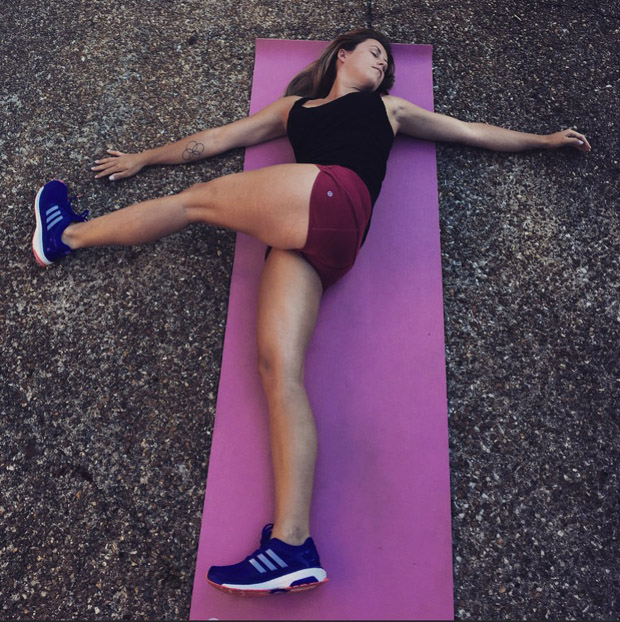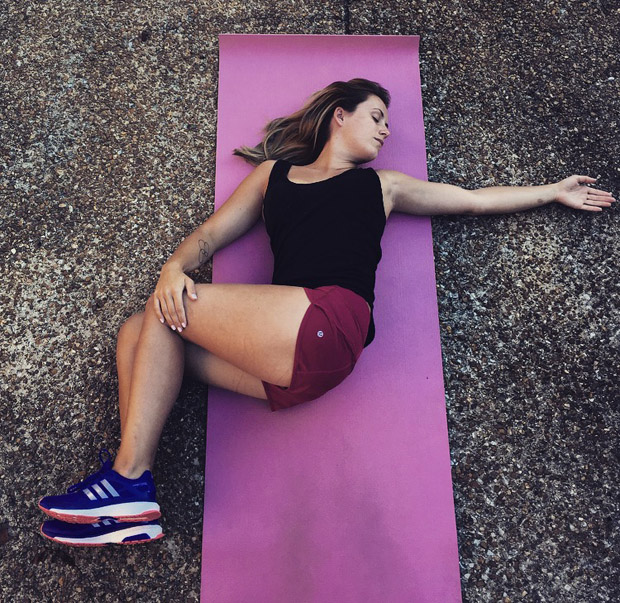Pose of the month: Reclined twist

As you work to run faster, or prepare and train for an upcoming marathon, it is important you allow your body to rest and restore. This month’s yoga pose will help you stretch your hips and rotator muscles while releasing tension in your lower back.
To do this pose, begin in corpse pose lying on your back. As you inhale, lift both knees to your chest. As you exhale, bring your arms around your knees to draw them closer to your chest. As you inhale and bring your right hand to the outside of your left knee and exhale drop both knees to the right side. Shift your hips as needed to the left to allow for a neutral spine. Inhale here and on your exhale extend your left arm out to the left (at shoulder height) with your palm facing the ground. Your right hand can remain resting on your left knee.

Once you are comfortable, turn your neck slightly left to look over your left shoulder. It is important that both shoulders are pressed firmly into the mat.
It is not important that your knees touch the floor, but that your shoulder remains grounded. If you feel pain or a “tweak” in your lower back, allow your knees to rest on a pillow, blanket or block. To make this pose even more restorative (perhaps you ran a few extra kilometres today,) try resting both knees and feet on a pillow or block, and place a blanket between each of your knees.
Hold this pose for 10-20 breaths before switching to the other side. Savasana is a great pose to do following reclined twist.
Reclined twist is extremely beneficial to all athletes including runners, stretching many key muscles while providing restorative benefits. It stretches your back muscles, hips and glutes. It lengthens and relaxes your spine and can help strengthen your abdominal muscles.
Spine
All twisting poses connect the lower and upper appendicular skeletons (the top and bottom halves of your body) to turn the axial skeleton (the spine and torso). This lengthens the spinal rotator muscles that attach from one vertebra to another, as well as the erector spinae, quadratus lumborum, and abdominal musculature.
While practicing a reclined twist, do your best to maintain a neutral spine. With both of your knees bent, as you move into your twist, it is easy to move into lumbar flexion (inward curve of your lower spine) so remain aware of your lower back at all times.
External Oblique
As you twist your lower body and ground your knees towards the right side of your body, the left external oblique will be stretched. Notice how this stretch feels.
Abdomen
In reclined twists the upper body is stabilized and so most of the twist happens in your spine as you rotate your legs. Here it’s important to pay attention to your core and make sure your shoulders remain grounded.
While your abdominal muscles are relaxed, being mindful of your abs will ensure you are not “over twisting” and can help you avoid feeling tension in your lower back.
Once you are comfortable in this pose, attempt to bring your breath to your abdomen or belly. Sending your breath here will help to release the tension in the abdominal wall and will help to reduce any tightness in the lumbar region of your spine.

Neck
If you are able to turn your head over your (opposite) shoulder during this twist, you will feel a stretch along the side of your neck, specifically in your sternocleidomastoid and scalenes muscles. Slowly allow your chin to come closer to your shoulder while avoiding any pain.
Legs
For a greater leg stretch and more intense abdominal work, try an extended leg version of this pose. To do this, begin in the same way bringing both legs to your chest on the inhale. As you exhale, extend your left leg straight up into the air and extend your arms out to each side. Inhale in this position and, as you exhale, drop your left leg towards your right hand, while keeping your leg long and extended. Your right leg should remain straight on the ground and should extend towards the bottom of your mat. Ensure that your right shoulder blade and upper back are connected to the ground.
Attempt to grab your left foot with your right hand. If this is too challenging, allow your left leg to come to the ground where it can, without lifting your right shoulder off the ground.
In this variation, the hamstrings of your top leg are lengthened and your foot is flexed. Your bottom leg should also be engaged, and can be internally rotating, or turning your foot and leg inwards, to provide additional support. As you extend your left leg out, pushing through your heel, you will also be stretching the entire left hip and butt, including the IT band, piriformis glute medius, and maximus.
Try this pose, twisting to each side, a few hours after your run to help restore and relax your body. This pose can be paired with simple breathing or mindfulness exercises to prepare you for your next big race.


